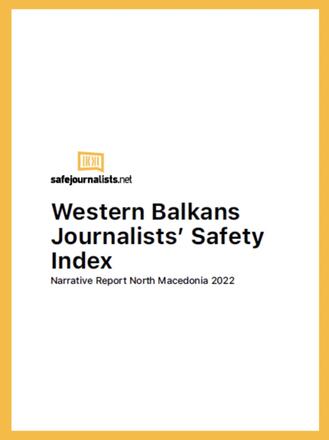
This report analyses the situation regarding the safety of journalists in 2022 compared to the previous year in North Macedonia. The Journalists' Safety Index score has slightly decreased from 4.28 in 2021 to 4.17 in 2022. The document encompasses the analysis of four main dimensions, each constituted by several indicators. These are: the legal and organisational environment, due prevention, due process and actual safety.
1. Legal and organisational environment
The 2022 Western Balkans Journalist Safety Index highlights the challenges in protecting journalists and media personnel, with an upwards trend of the number of defamation or insult cases. The lack of legal protection for SLAPP cases has led to an increase in such cases, resulting in the attempt of influential figures to put pressure on journalists. Although the protection of journalistic sources remained stable, journalism was negatively affected by the lack of whistleblowers reporting corruption. Selective accreditation and information denial of access by government agencies slightly worsened the professional freedom of journalists compared to 2021. Journalists in the private sector face lack of contracts, low and irregular salaries and the absence of trade unions. The public broadcasting service registered better conditions, characterised by employment contracts and the possibility to join trade unions.
2. Due prevention
A special prosecutor was appointed to monitor attacks against journalists. A new hotline for journalists was set up. However, only two of the seven registered attacks against journalists resulted in sanctions against the perpetrators. There were no major changes in physical protection measures, and the risk assessment process remained unclear. Despite the presence of legal measures, mechanisms to provide free legal assistance to victims of gender-based attacks, have not yet been established in practice. Following the application of international human rights standards and the promotion of joint training, police behaviour towards journalists and media has improved.
3. Due process
In 2022, some improvement resulting from the cooperation between relevant agencies in the Western Balkans has made the detection of perpetrators of attacks against journalists more efficient. However, this cooperation remains unsatisfactory, and the prosecution has been reluctant to start the proceedings. Impunity remained a serious issue. Low and ineffective investigations remained a problem, while individual perpetrators have yet to be prosecuted. Protection against online threats remains inadequate due to the lack of efficiency in sanctioning perpetrators. Courts and related agencies have yet to establish reliable statistical systems to provide accurate data on cases involving journalists and media.
4. Actual safety
2022 saw a slight increase in attacks against journalists and media personnel in North Macedonia. Only two cases of non-physical threats and harassment were recorded, compared to seven in 2020 and three in 2021. However, the level of impunity for such attacks remained high, with only 2 out of the 10 cases resulting in court rulings in the last two years. Regarding threats against the lives of journalists, only in one case out of four the prosecution took action. Three actual attacks were registered in 2022, an increase compared to the previous years. However, the conduct of judicial authorities was overall positive.
Tags: North Macedonia Safety of journalists Media freedomThe content of this article can be used according to the terms of Creative Commons: Attribution-NonCommercial 4.0 International (CC BY-NC 4.0) . To do so use the the wording "this article was originally published on the Resource Centre on Media Freedom in Europe" including a direct active link to the original article page.

